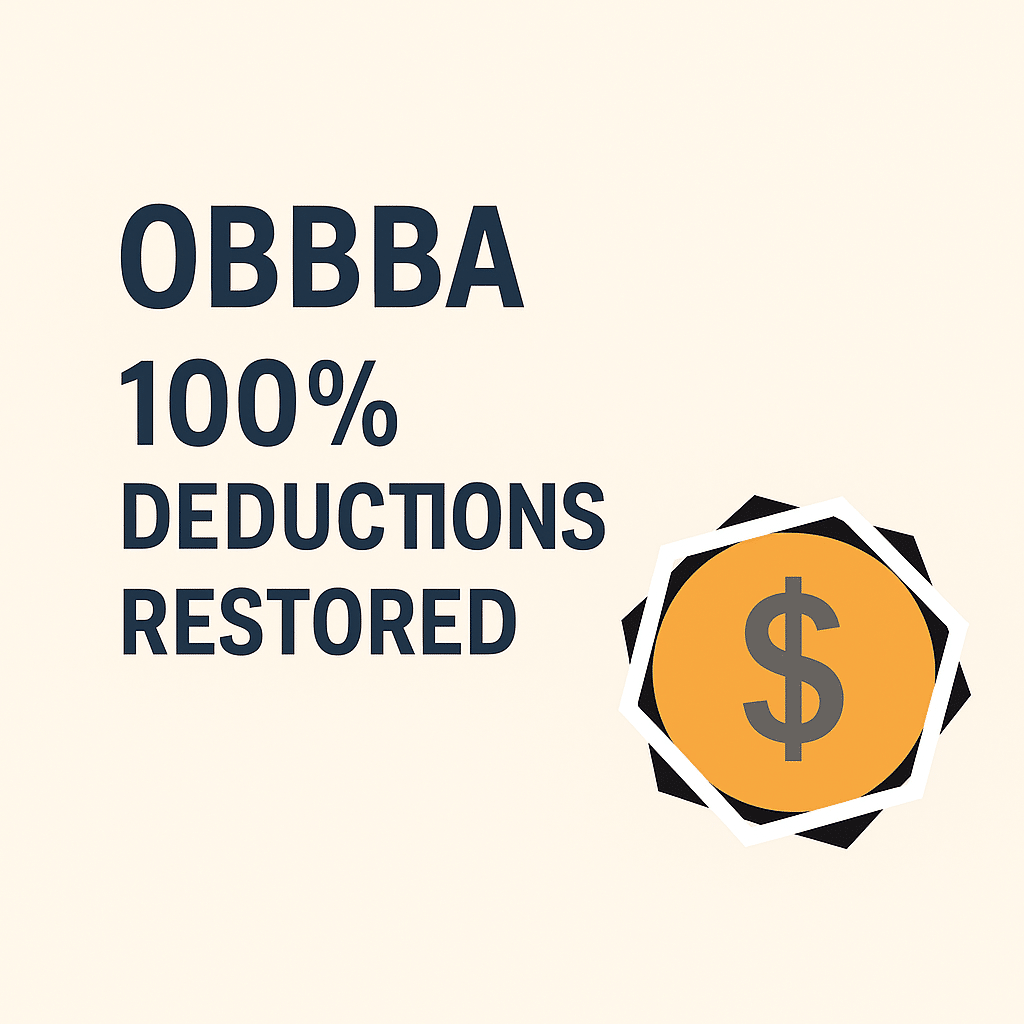The newly enacted One Big Beautiful Bill Act (OBBBA) has re-energized tax planning for business owners. It restores full expensing for many assets, permanently revives 100% bonus depreciation, and introduces an entirely new deduction for production property.
Here’s how these updates can reduce your tax liability and create major cash-flow advantages for 2025 and beyond.
1. Permanent 100% Bonus Depreciation
Beginning January 20, 2025, businesses can deduct 100% of the cost of qualifying property in the first year it’s placed in service. This includes:
• Equipment, furniture, and fixtures
• Off-the-shelf software
• Land improvements such as landscaping, fences, and driveways
• Non-structural interior improvements to commercial buildings (qualified improvement property)
Before OBBBA, bonus depreciation was set to phase down to 40% in 2025. Now, it’s permanent.
Bonus depreciation can’t be used for land, buildings, inventory, intangibles, or property used outside the United States. Passenger vehicles remain capped at a $20,200 total first-year deduction (including the $8,000 bonus limit), while vehicles weighing more than 6,000 lbs used fully for business may be fully deducted.
2. Cost Segregation: A Game-Changer for Property Owners
Owners of commercial and residential rental property can leverage OBBBA’s 100% bonus depreciation through cost segregation studies. These studies break a property into components such as personal property and land improvements that can be depreciated faster—typically 20 to 30 percent of a building’s value.
This approach can generate substantial first-year write-offs, improving ROI and freeing cash for reinvestment.
Planning tip: Schedule your engineering study early—firms specializing in cost segregation are expected to be in high demand.
3. Section 179 Expensing Doubled
Section 179 limits have increased dramatically: businesses can now deduct up to $2.5 million (2025), compared with $1.22 million in 2024.
The deduction phases out starting at $4 million in property placed in service and disappears above $6.5 million.
Section 179 covers the same property types as bonus depreciation, plus certain exterior improvements such as roofs and HVAC systems. Because bonus depreciation is now unlimited and automatic, many taxpayers will rely less on Section 179.
4. Section 179 vs. Bonus Depreciation
| Feature | Bonus Depreciation | Section 179 |
|---|---|---|
| Annual limit | None | $2.5 million (phased out > $4 million) |
| Income limitation | None | Limited to business income |
| Automatic | Yes (unless you elect out) | Must be claimed on Form 4562 |
| Class-wide | Yes | You may pick specific assets |
| Recapture | Listed property only | Recaptured if use drops ≤ 50% |
For most small and mid-size businesses, bonus depreciation will now be the simpler and more flexible option.
5. New 100% Deduction for Qualified Production Property
Manufacturers and producers receive a powerful new deduction: 100% write-off for “qualified production property.”
Eligible property must be:
• Non-residential real property used directly in manufacturing or refining
• Constructed between January 20, 2025 and December 31, 2028
• Placed in service before January 1, 2031
• Located in the U.S. or its territories
Qualifying activities include transforming raw materials—such as turning pulp into paper or metal rods into bolts. Office, administrative, retail, and lodging areas don’t qualify.
You can also purchase and rehabilitate an unused manufacturing facility if it wasn’t in production use between 2021 and May 2025. The property must remain in use for at least 10 years to avoid recapture.
6. Key Takeaways
• 100% bonus depreciation is now permanent for property placed in service after January 20, 2025.
• Section 179 expensing limit rises to $2.5 million with phase-outs beginning at $4 million.
• Cost segregation remains essential for maximizing deductions on rental and commercial real estate.
• Manufacturers can claim full deductions for qualifying facilities through 2030.
These changes make 2025 one of the most favorable years in recent history for capital investment.
Ready to Take Advantage?
Reckenen Inc. helps business owners model and document depreciation strategies to maximize tax benefits under the OBBBA.
👉 Tax Planning Services
👉 CFO & Advisory Services
👉 Book a Strategy Call
Legal Disclaimer
This material is provided for informational purposes only and should not be construed as legal, accounting, or tax advice. You should consult your tax advisor before making any decisions based on this information. Tax laws are subject to change, and interpretations may vary by circumstance.

